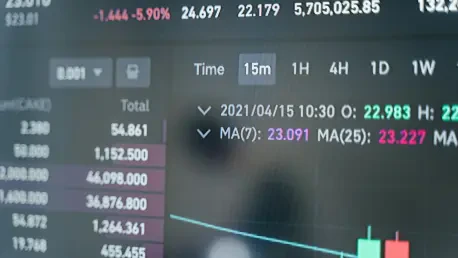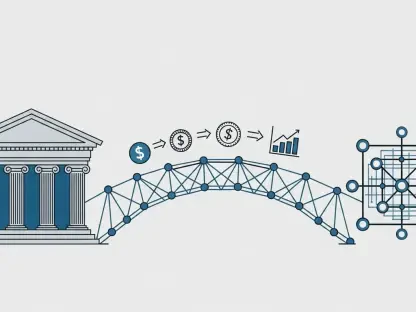Market Snapshot: The Rise of a Digital Equity Era
Imagine a world where stock trading happens instantly, 24/7, across borders, with settlement times reduced from days to mere seconds, and this is no longer a distant dream but a reality unfolding through stock tokenization. This blockchain-driven innovation is transforming the financial landscape, and as of 2025, the tokenized stock market, though valued at a modest $370 million against the colossal $120 trillion global equities market according to BNB Chain data, signals a seismic shift in how ownership and value are managed. This analysis aims to dissect the current state of this emerging sector, uncover key trends, and project its trajectory, offering critical insights for stakeholders navigating this digital frontier.
The significance of this market evolution lies in its potential to address entrenched inefficiencies in traditional finance, such as delayed settlements and restricted trading hours, while broadening access for global investors. Tokenization converts traditional equities into digital tokens on a blockchain, enabling programmable assets and continuous trading. This examination will provide a detailed perspective on the forces shaping this space, from technological advancements to regulatory challenges, and why it matters for the future of investment.
Understanding the dynamics of tokenized stocks is essential for financial institutions, investors, and policymakers aiming to stay ahead in a rapidly digitizing economy. The following sections will break down current market patterns, analyze data-driven insights, and forecast growth opportunities, setting the stage for strategic decision-making in an era of unprecedented change.
Deep Dive into Market Trends and Data
Current Landscape: A Niche Market with Explosive Potential
As of 2025, stock tokenization remains a niche segment, representing just a fraction of the broader equities market. The $370 million valuation, while small, reflects a burgeoning interest in blockchain-based assets, driven by the promise of efficiency and accessibility. Unlike traditional markets constrained by operational hours and intermediaries, tokenized stocks leverage blockchain’s decentralized ledger to enable real-time transactions, slashing settlement delays and reducing costs. This early-stage adoption is evident in pilot projects by major financial players experimenting with tokenizing private placements and fractional shares.
Data from industry reports highlights a growing appetite for digital assets among retail and institutional investors seeking alternative investment avenues. The ability to trade globally without time zone limitations is a key draw, particularly in regions with underdeveloped financial infrastructure. However, the limited scale of adoption underscores a critical gap—mainstream integration hinges on overcoming technical and legal barriers that currently restrict broader market penetration.
This nascent stage also reveals a disparity in adoption rates across different market segments. While tech-savvy investors and fintech startups are quick to embrace tokenization, traditional institutions remain cautious, often citing uncertainty around compliance as a deterrent. Bridging this divide will be crucial for scaling the market, a theme that ties directly into the regulatory and technological trends shaping this space.
Technological Drivers: Blockchain Innovations Fueling Growth
At the heart of stock tokenization lies blockchain technology, which provides the secure, transparent framework necessary for digitizing equities. Innovations such as smart contracts enable automated processes like dividend payouts and voting rights, enhancing the functionality of tokenized assets. Additionally, standards like ERC-3643 for on-chain identity verification are emerging as tools to ensure compliance, though they introduce complexities such as increased transaction costs that could temper adoption in cost-sensitive markets.
Another pivotal advancement is the development of custodial control mechanisms, which aim to safeguard investor assets while maintaining the flexibility of blockchain systems. These solutions are vital for building trust among conservative investors wary of decentralized models. Yet, the trade-off often involves reduced composability with decentralized finance (DeFi) ecosystems, limiting the potential for tokenized stocks to be used as collateral or in lending protocols.
The pace of technological progress suggests a robust pipeline of solutions addressing current limitations. For instance, improvements in scalability and interoperability between blockchain networks could unlock seamless cross-border trading, a cornerstone of tokenization’s value proposition. As these tools mature, they are likely to catalyze a shift from experimental projects to widespread implementation, reshaping investor expectations and market structures.
Regulatory Headwinds: Navigating a Fragmented Landscape
Regulatory fragmentation stands as a formidable barrier to the global expansion of tokenized stock markets. Jurisdictions worldwide apply disparate rules to security tokens, creating a complex web of compliance requirements for issuers. For example, a token deemed compliant under U.S. SEC guidelines might fail to meet the European Union’s MiFID II standards, hindering cross-border offerings and frustrating efforts to create universally accepted assets.
This inconsistency contrasts sharply with traditional stock markets, which have benefited from decades of regulatory harmonization in major financial hubs. The absence of a unified framework for tokenized assets risks stifling the 24/7 trading vision that blockchain promises. Progressive regions like Singapore and Switzerland, with their innovation-friendly policies, are emerging as leaders, potentially creating an uneven playing field where access to tokenized markets varies widely by geography.
Efforts to address this challenge are underway, with industry stakeholders advocating for collaborative standardization. While a global consensus remains elusive, localized regulatory clarity in key markets could serve as a stepping stone, encouraging issuers to test tokenized offerings in supportive environments. Until broader alignment is achieved, navigating this patchwork of rules will remain a critical concern for market participants.
Projections: Mapping the Future of Tokenized Equities
Growth Forecasts: A Tenfold Surge on the Horizon
Looking ahead, industry projections paint an optimistic picture for stock tokenization, anticipating a tenfold increase in market size by 2027 if even a small portion of the $120 trillion global equities market shifts to blockchain platforms. This forecast is underpinned by rising demand for continuous trading and programmable assets, which align with the digital-first preferences of younger investor demographics and tech-driven financial institutions.
Economic factors, such as the growing interest in alternative investments amid volatile traditional markets, are expected to accelerate this transition. Tokenized stocks offer unique opportunities like fractional ownership, lowering entry barriers for retail investors and democratizing access to high-value assets. If regulatory and technological hurdles are addressed, this could trigger a rapid influx of capital into the sector over the next few years.
However, potential disruptions loom, including stringent policy shifts or unforeseen technical setbacks that could derail growth. The trajectory will likely favor regions with clear, supportive regulations, potentially widening the gap between early adopters and slower-moving markets. Monitoring these variables will be essential for stakeholders aiming to capitalize on the projected expansion.
Emerging Opportunities: Redefining Financial Products
Beyond sheer market growth, tokenization is poised to spawn innovative financial products that redefine investment paradigms. Concepts such as automated dividend distribution via smart contracts and tokenized fractional shares are gaining traction, offering investors new ways to engage with equity markets. These developments could unlock liquidity in previously illiquid assets, further expanding market reach.
Integration with DeFi ecosystems presents another frontier, where tokenized stocks could serve as collateral in lending protocols or underpin novel derivative products. While current regulatory constraints limit such applications, evolving frameworks and hybrid token models may bridge the gap between compliance and utility, creating a fertile ground for experimentation.
The speculative potential of these opportunities hinges on resolving existing tensions around ownership rights and market trust. If successful, these innovations could position tokenized stocks as a cornerstone of a borderless financial system, fundamentally altering how value is created and exchanged in global markets. Keeping pace with these shifts will require agility and foresight from all involved parties.
Reflecting on the Market Analysis: Strategic Pathways Forward
Looking back on this market analysis, it becomes evident that stock tokenization has carved out a transformative niche within the financial sector in 2025, despite its modest $370 million valuation. The examination of trends reveals a powerful undercurrent of technological innovation and investor demand driving the sector forward, tempered by significant regulatory and structural challenges. The projections underscore a future ripe with opportunity, provided stakeholders navigate the complexities of compliance and scalability.
A critical takeaway from this reflection is the urgent need for standardized regulatory frameworks to unlock the global potential of tokenized equities. Collaborative efforts between industry leaders and policymakers emerge as a linchpin for success, offering a pathway to harmonize rules without stifling innovation. For businesses and investors, this means prioritizing partnerships with legal and tech experts to stay compliant while exploring pilot projects in progressive jurisdictions.
Moving into the next phase, financial institutions should focus on educating the market about the benefits and risks of tokenization to build trust and drive adoption. Experimenting with hybrid token designs that balance ownership rights with DeFi utility offers a practical step toward mainstream integration. By taking these strategic actions, stakeholders can position themselves to lead in a financial landscape increasingly defined by digital disruption, ensuring they are ready for the exponential growth anticipated in the years ahead.









